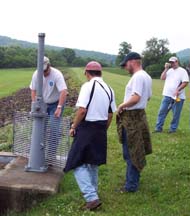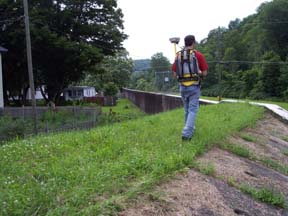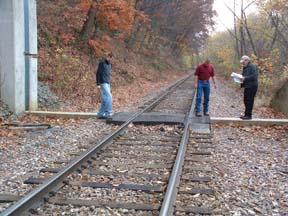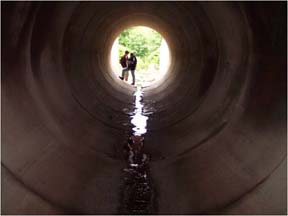


Why Inspection?
Flood risk and levee condition are dynamic. Levees change over time: banks erode, closures rust, animals burrow, and pumps wear out. Ongoing vigilance is needed to ensure that levee infrastructure will perform properly during a flood event. USACE regularly inspects levees within its Levee Safety Program to monitor their overall condition, identify deficiencies, verify that needed maintenance is taking place, determine eligibility for federal rehabilitation assistance (in accordance with P.L. 84-99), and provide information about the levees on which the public relies. Inspection information also contributes to risk assessments and supports levee accreditation decisions for the National Flood Insurance Program administered by the Federal Emergency Management Agency (FEMA).
Two Types of Inspections
USACE now conducts two types of levee inspections using a Geographic Information Systems (GIS) / Global Positioning System (GPS)-based inspection tool that incorporates a standard levee inspection checklist. Levee sponsors are encouraged to be part of the inspection team.
- Routine Inspection is a visual inspection to verify and rate levee system operation and maintenance. It is typically conducted each year for all levees in the USACE Levee Safety Program.
- Periodic Inspection is a comprehensive inspection conducted by a USACE multidisciplinary team that includes the levee sponsor and is led by a professional engineer. USACE typically conducts this inspection every five years on the federally authorized levees in the USACE Levee Safety Program. Periodic Inspections include three key steps:
- Data collection: A review of existing data on operation and maintenance, previous inspections, emergency action plans and flood fighting records
- Field inspection: Similar to the visual inspection for a Routine Inspection, but with additional features
- Final report development: A report including the data collected, field inspection findings, an evaluation of any changes in design criteria from the time the levee was constructed, and additional recommendations as warranted, such as areas that need further evaluation.
Inspection Ratings
Both Routine and Periodic Inspections result in a final inspection rating for operation and maintenance. The rating is based on the levee inspection checklist, which includes 125 specific items dealing with operation and maintenance of levee embankments, floodwalls, interior drainage, pump stations, and channels.
Each levee segment receives an overall segment inspection rating of Acceptable, Minimally Acceptable, or Unacceptable. If a levee system comprises one or more levee segments (if there are different levee sponsors for different parts of the levee) then the overall levee system rating is the lowest of the segment ratings.
| Levee System Inspection Ratings |
| Acceptable |
All inspection items are rated as Acceptable. |
| Minimally Acceptable |
One or more inspection items are rated as Minimally Acceptable or one or more items are rated as Unacceptable and an engineering determination concludes that the Unacceptable inspection items would not prevent the segment/system from performing as intended during the next flood event. |
| Unacceptable |
One or more inspection items are rated as Unacceptable and would prevent the segment/system from performing as intended, or a serious deficiency noted in past inspections (previous Unacceptable items in a Minimally Acceptable overall rating) has not been corrected within the established timeframe, not to exceed two years. |
 A levee sponsor must maintain the levee to at least the minimally acceptable standard to remain eligible for federal rehabilitation assistance through the USACE Rehabilitation and Inspection Program (PL 84-99).
A levee sponsor must maintain the levee to at least the minimally acceptable standard to remain eligible for federal rehabilitation assistance through the USACE Rehabilitation and Inspection Program (PL 84-99).
Sharing the Results
USACE shares inspection results with the authority responsible for levee operation and maintenance, known as the levee sponsor. This is typically a local agency but in some cases is USACE itself. USACE also shares the results with FEMA, to help inform decisions about levee accreditation for flood insurance purposes. The inspection ratings are available in the National Levee Database.
Learn More